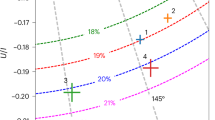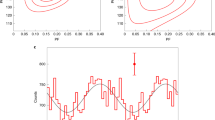Abstract
Pulsars with periods of a few milliseconds1,2 test theories of the radio emission process in extreme conditions. The velocity of light radius, which is an important scale-length in most theories, is less than 10 stellar radii for the millisecond pulsar PSR1937 + 214, and the inferred surface magnetic field is a few times 108 G, less than 10−3 that inferred for the Crab pulsar. Polarization observations across both the main pulse and the prominent interpulse can help clarify the emission geometry and probe similarities between this pulsar and others, such as the Crab pulsar, that have very different magnetospheric conditions. High-frequency polarization observations exist for this pulsar3,4, but the temporal smearing produced by interstellar dispersion has hampered low-frequency observations. We now report polarization observations at 431 MHz that have 4 µs time resolution and are free from the effects of interstellar dispersion. We find that the interpulse polarization decreases towards lower frequencies, opposite in trend to the polarization of the main pulse and of most other pulsars. The position angles at the centre of the main pulse and interpulse are approximately equal and the position angle gradients have the same sign, supporting a model in which the main pulse and interpulse are emitted above opposite magnetic poles.
This is a preview of subscription content, access via your institution
Access options
Subscribe to this journal
Receive 51 print issues and online access
$199.00 per year
only $3.90 per issue
Buy this article
- Purchase on Springer Link
- Instant access to full article PDF
Prices may be subject to local taxes which are calculated during checkout
Similar content being viewed by others
References
Backer, D. C., Kulkarni, S. R., Heiles, C., Davis, M. M. & Goss, W. M. Nature 300, 615–618 (1982).
Boriakoff, V., Buccheri, R. & Fauci, F. Nature 304, 417–419 (1983).
Ashworth, M., Lyne, A. G. & Smith, F. G. Nature 301, 313–314 (1983).
Stinebring, D. R. Nature 302, 690–692 (1983).
Hankins, T. H. & Rickett, B. J. Meth. comp. Phys. 14, 55–129 (1975).
Cordes, J. M. & Stinebring, D. R. Astrophys. J. Lett. (in the press).
Rankin, J. M. Astrophys. J. 162, 707–725 (1970).
Manchester, R. N. Astrophys. J. Lett. 163, L61–L63 (1971).
Manchester, R. N. Astrophys. J. Lett. 179, L7–L10 (1973).
Morris, D., Graham, D. A. & Sieber, W. Astr. Astrophys. 100, 107–112 (1981).
Manchester, R. N. & Lyne, A. G. Mon. Not. R. astr. Soc. 181, 761–767 (1977).
Hankins, T. H. & Cordes, J. M. Astrophys. J. 249, 241–253 (1981).
Narayan, R. & Vivekanand, M. Astr. Astrophys. 122, 45–53 (1983).
Author information
Authors and Affiliations
Rights and permissions
About this article
Cite this article
Stinebring, D., Cordes, J. Low-frequency polarimetry of the millisecond pulsar PSR1937 + 214. Nature 306, 349–351 (1983). https://doi.org/10.1038/306349a0
Received:
Accepted:
Issue Date:
DOI: https://doi.org/10.1038/306349a0
This article is cited by
-
Millisecond pulsars
Journal of Astrophysics and Astronomy (1984)
Comments
By submitting a comment you agree to abide by our Terms and Community Guidelines. If you find something abusive or that does not comply with our terms or guidelines please flag it as inappropriate.



